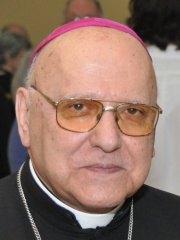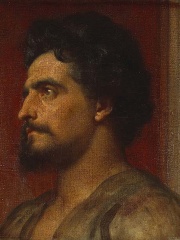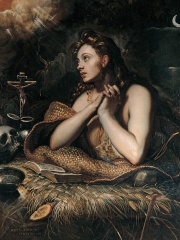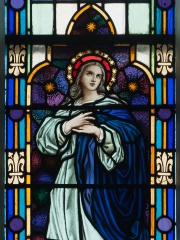
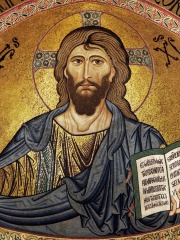
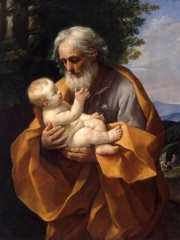
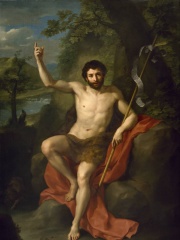
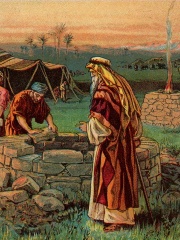
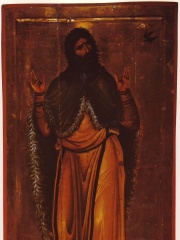
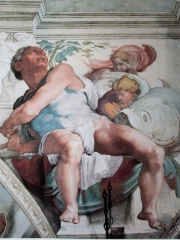
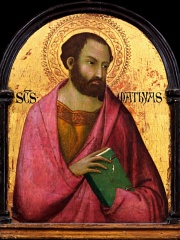
The Most Famous
RELIGIOUS FIGURES from Israel
This page contains a list of the greatest Israeli Religious Figures. The pantheon dataset contains 3,187 Religious Figures, 56 of which were born in Israel. This makes Israel the birth place of the 12th most number of Religious Figures behind India, and Poland.
Top 10
The following people are considered by Pantheon to be the top 10 most legendary Israeli Religious Figures of all time. This list of famous Israeli Religious Figures is sorted by HPI (Historical Popularity Index), a metric that aggregates information on a biography's online popularity. Visit the rankings page to view the entire list of Israeli Religious Figures.

1. Mary, mother of Jesus (100 BC - 100)
With an HPI of 96.94, Mary, mother of Jesus is the most famous Israeli Religious Figure. Her biography has been translated into 154 different languages on wikipedia.
Mary was a first-century Jewish woman of Nazareth, the wife of Joseph and the mother of Jesus. She is an important figure of Christianity, venerated under various titles such as virgin or queen, many of them mentioned in the Litany of Loreto. The Eastern and Oriental Orthodox, Catholic, Evangelical Lutheran, Reformed, Anglican, Methodist and Baptist churches believe that Mary, as mother of Jesus, is the Mother of God. The Church of the East historically regarded her as Christotokos, a term still used in Assyrian Church of the East liturgy. She has the highest position in Islam among all women and is mentioned numerous times in the Quran, including in a chapter named after her. She is also revered in the Baháʼí Faith and the Druze Faith. The synoptic Gospels name Mary as the mother of Jesus. The gospels of Matthew and Luke describe Mary as a virgin who was chosen by God to conceive Jesus through the Holy Spirit. After giving birth to Jesus in Bethlehem, she and her husband Joseph raised him in the city of Nazareth in Galilee, and she was in Jerusalem at his crucifixion and with the apostles after his ascension. Although her later life is not accounted in the Bible; Catholic, Eastern Orthodox, and some Protestant traditions believe that her body was raised into heaven at the end of her earthly life, which is known in Western Christianity as the Assumption of Mary and in Eastern Christianity as the Dormition of the Mother of God. Mary has been venerated since early Christianity, and is often considered to be the holiest and greatest saint. There is a certain diversity in the Mariology and devotional practices of major Christian traditions. The Catholic Church and some Oriental Orthodox Churches hold distinctive Marian dogmas, namely her Immaculate Conception and her bodily Assumption into heaven. Many Protestants hold various views of Mary's role that they perceive as being in accordance with the Scriptures. The Confessions of the Lutheran Churches have taught the virgin birth, Theotokos, and perpetual virginity. The multiple forms of Marian devotions include various prayers and hymns, the celebration of several Marian feast days in liturgy, the veneration of images and relics, the construction of churches dedicated to her and pilgrimages to Marian shrines. Many Marian apparitions and miracles attributed to her intercession have been reported by believers over the centuries. She has been a traditional subject in arts, notably in Byzantine art, medieval art and Renaissance art.

2. Jesus (4 BC - 33)
With an HPI of 94.24, Jesus is the 2nd most famous Israeli Religious Figure. His biography has been translated into 274 different languages.
Jesus (c. 6 to 4 BC – AD 30 or 33), also referred to as Jesus Christ, Jesus of Nazareth, and many other names and titles, was a 1st-century Jewish preacher and religious leader in the Roman province of Judaea. He is the central figure of Christianity, the world's largest religion. Virtually all Christians consider Jesus to be the incarnation of God the Son and awaited messiah, or Christ, a descendant from the Davidic line that is prophesied in the Old Testament. Virtually all modern scholars of antiquity agree that Jesus existed historically. Accounts of Jesus's life are contained in the Gospels, especially the four canonical Gospels in the New Testament. Since the Enlightenment, academic research has yielded various views on the historical reliability of the Gospels and how closely they reflect the historical Jesus. According to Christian tradition, as preserved in the Gospels and the Acts of the Apostles, Jesus was circumcised at eight days old, was baptized by John the Baptist as a young adult, and after 40 days and nights of fasting in the wilderness, began his own ministry. He was an itinerant teacher who interpreted the law of God with divine authority and was often referred to as "rabbi". Jesus often debated with his fellow Jews on how to best follow God, engaged in healings, taught in parables, and gathered followers, among whom 12 were appointed as his apostles. He was arrested in Jerusalem and tried by the Jewish authorities, handed over to the Roman government, and crucified on the order of Pontius Pilate, the Roman prefect of Judaea. After his death, his followers became convinced that he rose from the dead, and the community they formed eventually became the early Christian Church that expanded as a worldwide movement. Christian theology includes the beliefs that Jesus was conceived by the Holy Spirit, was born of a virgin named Mary, performed miracles, founded the Christian Church, died by crucifixion as a sacrifice to achieve atonement for sin, rose from the dead on the third day, and ascended into Heaven from where he will return. Commonly, Christians believe Jesus enables people to be reconciled to God. The Nicene Creed asserts that Jesus will judge the living and the dead, either before or after their bodily resurrection, an event tied to the Second Coming of Jesus in Christian eschatology. The great majority of Christians worship Jesus as the incarnation of God the Son, the second of three persons of the Trinity. The birth of Jesus is celebrated annually, generally on 25 December, as Christmas. His crucifixion is honoured on Good Friday and his resurrection on Easter Sunday. The world's most widely used calendar era—in which the current year is AD 2025 (or 2025 CE)—is based on the approximate date of the birth of Jesus. Judaism rejects the belief that Jesus was the awaited messiah, arguing that he did not fulfill messianic prophecies, was not lawfully anointed and was neither divine nor resurrected. In contrast, Jesus in Islam is considered the messiah and a prophet of God, who was sent to the Israelites and will return to Earth before the Day of Judgement. Muslims believe Jesus was born of the virgin Mary but was neither God nor a son of God. Most Muslims do not believe that he was killed or crucified but that God raised him into Heaven while he was still alive. Jesus is also revered in the Baháʼí and the Druze faiths, as well as in Rastafari.

3. Saint Joseph (100 BC - 100)
With an HPI of 90.76, Saint Joseph is the 3rd most famous Israeli Religious Figure. His biography has been translated into 88 different languages.
According to the canonical Gospels, Joseph was a 1st-century Jewish man of Nazareth who was married to Mary, the mother of Jesus, and was the legal father of Jesus. Joseph is venerated as Saint Joseph in the Catholic Church, Eastern Orthodox Church, Oriental Orthodox Church, Anglicanism and Lutheranism. In Catholic traditions, Joseph is regarded as the patron saint of workers and is associated with various feast days. The month of March is dedicated to Saint Joseph. Pope Pius IX declared him to be both the patron and the protector of the Catholic Church, in addition to his patronages of the sick and of a holy death, due to the belief that he died in the presence of Jesus and Mary. Joseph has become patron of various dioceses and places. Being a patron saint of virgins, he is venerated as "most chaste". The veneration of the pure and most Chaste Heart of Joseph has, in contrast to the Most Sacred Heart of Jesus and the Immaculate Heart of Mary, no liturgical cultus, but is a private devotion. Several venerated images of Saint Joseph have been granted a decree of canonical coronation by a pontiff. Religious iconography often depicts him with lilies or spikenard. With the present-day growth of Mariology, the theological field of Josephology has also grown and since the 1950s centers for studying it have been formed.

4. John the Baptist (20 BC - 31)
With an HPI of 89.07, John the Baptist is the 4th most famous Israeli Religious Figure. His biography has been translated into 112 different languages.
John the Baptist (c. 6 BC – c. AD 30) was a Jewish preacher active in the area of the Jordan River in the early first century AD. He is also known as Saint John the Forerunner in Eastern Orthodoxy and Oriental Orthodoxy, Saint John the Immerser in the Baptist tradition, and as the prophet Yahya ibn Zakariya in Islam. He is sometimes referred to as John the Baptiser. John is mentioned by the Roman Jewish historian Josephus, and he is revered as a major religious figure in Christianity, Islam, the Baháʼí Faith, the Druze faith, and Mandaeism; in the last of these he is considered to be the final and most vital prophet. He is considered to be a prophet of God by all of the aforementioned faiths, and is honoured as a saint in many Christian denominations. According to the New Testament, John anticipated a messianic figure greater than himself; in the Gospels, he is portrayed as the precursor or forerunner of Jesus. According to the Gospel of Matthew, Jesus himself identifies John as "Elijah who is to come", which is a direct reference to the Book of Malachi (Malachi 4:5), as confirmed by the angel Gabriel, who announced John's birth to his father Zechariah. According to the Gospel of Luke, John and Jesus were relatives. Some scholars think that John belonged to the Essenes, a semi-ascetic Jewish sect who expected a messiah and practised ritual baptism. John used baptism as the central symbol or sacrament of his pre-messianic movement. Most biblical scholars agree that John baptized Jesus, and several New Testament accounts report that some of Jesus's early followers had previously been followers of John. According to the New Testament, John was sentenced to death and subsequently beheaded by Herod Antipas around AD 30 after John rebuked him for divorcing his wife and then unlawfully wedding Herodias, the wife of his brother Herod Philip I. Josephus also mentions John in the Antiquities of the Jews and states that he was executed by order of Herod Antipas in the fortress at Machaerus. Followers of John existed into the second century AD, and some proclaimed him to be the Messiah awaited by Jews. In modern times, the followers of John the Baptist are the Mandaeans, an ancient ethnoreligious group who believe that he is their greatest and final prophet. In the Roman martyrology, John is the only saint whose birth and death are both commemorated.
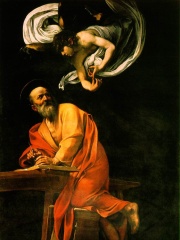
5. Matthew the Apostle (10 - 74)
With an HPI of 88.31, Matthew the Apostle is the 5th most famous Israeli Religious Figure. His biography has been translated into 90 different languages.
Matthew the Apostle was one of the twelve apostles of Jesus. According to Christian traditions, he was also one of the four Evangelists as author of the Gospel of Matthew, and thus is also known as Matthew the Evangelist. The New Testament records that as an Apostle, he followed Jesus. Church Fathers, such as Irenaeus and Clement of Alexandria, relate that Matthew preached the gospel in Judea before going to other countries. The claim of his gospel authorship is rejected by most critical biblical scholars, though the "traditional authorship still has its defenders."

6. Isaac (1900 BC - 1533 BC)
With an HPI of 86.63, Isaac is the 6th most famous Israeli Religious Figure. His biography has been translated into 93 different languages.
Isaac is one of the three patriarchs of the Israelites and an important figure in the Abrahamic religions, including Judaism, Samaritanism, Christianity, Islam, the Baháʼí Faith, and Rastafari. Isaac first appears in the Torah, in which he is the son of Abraham and Sarah, the father of Jacob and Esau, and the grandfather of the twelve tribes of Israel. Isaac's name means "he will laugh", reflecting the laughter, in disbelief, of Abraham and Sarah, when told by God that they would have a child. He is the only patriarch whose name was not changed, and the only one who did not move out of Canaan. According to the narrative, he died aged 180, the longest-lived of the three patriarchs. Recent scholarship has discussed the possibility that Isaac could have originally been an ancestor from the Beersheba region who was venerated at a sanctuary.

7. Elijah (1000 BC - 900 BC)
With an HPI of 85.72, Elijah is the 7th most famous Israeli Religious Figure. His biography has been translated into 87 different languages.
Elijah ( ih-LEYE-jə or ih-LEYE-zhə) or Elias ("My God is Yahweh/YHWH") was a prophet and miracle worker who lived in the northern kingdom of Israel during the reign of King Ahab (9th century BC), according to the Books of Kings in the Hebrew Bible. In 1 Kings 18, Elijah defended the worship of the Hebrew deity Yahweh over that of the Canaanite deity Baal. God also performed many miracles through Elijah, including resurrection, bringing fire down from the sky, and ascending to heaven alive. He is also portrayed as leading a school of prophets known as "the sons of the prophets". Following Elijah's ascension, his disciple and devoted assistant Elisha took over as leader of this school. The Book of Malachi prophesies Elijah's return "before the coming of the great and terrible day of the LORD", making him a harbinger of the Messiah and of the eschaton in various faiths that revere the Hebrew Bible. References to Elijah appear in Sirach, the New Testament, the Mishnah and Talmud, the Quran, the Book of Mormon, and Baháʼí writings. Scholars generally agree that a historical figure named Elijah existed in ancient Israel, though the biblical accounts of his life are considered more legendary and theologically reflective than historically accurate. In Judaism, Elijah's name is invoked at the weekly Havdalah rite that marks the end of Shabbat, and Elijah is invoked in other Jewish customs, among them the Passover Seder and the brit milah (ritual circumcision). He appears in numerous stories and references in the Haggadah and rabbinic literature, including the Babylonian Talmud. According to some Jewish interpretations, Elijah will return during the End of Times. The Christian New Testament notes that some people thought that Jesus was, in some sense, Elijah, but it also makes clear that John the Baptist is "the Elijah" who was promised to come in Malachi 3:1; 4:5. According to accounts in all three of the Synoptic Gospels, Elijah appeared with Moses during the Transfiguration of Jesus. Elijah in Islam appears in the Quran as a prophet and messenger of God, where his biblical narrative of preaching against the worshipers of Baal is recounted in a concise form. Due to his importance to Muslims, Catholics, and Orthodox Christians, Elijah has been venerated as the patron saint of Bosnia and Herzegovina

8. Jonah (850 BC - 810 BC)
With an HPI of 84.79, Jonah is the 8th most famous Israeli Religious Figure. His biography has been translated into 68 different languages.
Jonah the son of Amittai or Jonas (Hebrew: יוֹנָה Yōnā, lit. 'dove') was a Jewish prophet from Gath-hepher in the Northern Kingdom of Israel around the 8th century BCE according to the Hebrew Bible. He is the central figure of the Book of Jonah, one of the minor prophets, which details his reluctance in delivering the judgment of God to the city of Nineveh (near present-day Mosul) in the Neo-Assyrian Empire. After he is swallowed by a large sea creature (Hebrew: דג גדול, romanized: dāḡ gāḏol, lit. 'large fish') and then released, he returns to the divine mission. In Judaism, the story of Jonah represents the teaching of repentance in Judaism, the ability to repent to God for forgiveness. In the New Testament of Christianity, Jesus calls himself "greater than Jonah" and promises the Pharisees "the sign of Jonah" when referring to his resurrection. Early Christian interpreters viewed Jonah as a type of Jesus. Jonah in Islam is regarded as a prophet and the narrative of Jonah appears in a surah of the Quran named after him, Yūnus. Many modern Bible scholars suggest the Book of Jonah is fictional, and at least partially satirical. Most scholars consider the Book of Jonah to have been composed long after the events it describes due to its use of words and motifs exclusive to postexilic Aramaic sources. The character of Jonah son of Amittai may have been based on the historical prophet of the same name who prophesied during the reign of King Amaziah of Judah, as mentioned in 2 Kings. Although the creature that swallowed Jonah is often depicted in art and culture as a whale, the Hebrew text uses the phrase "large fish". In the 17th century and early 18th century, the species of the fish that swallowed Jonah was the subject of speculation by naturalists, who interpreted the story as an account of a historical incident. Some modern scholars of folklore, on the other hand, note similarities between Jonah and other legendary religious figures, like the Indian yogi Matsyendranatha "Lord of the Fishes", the Sumerian king Gilgamesh, and the Greek hero Jason.

9. Matthias the Apostle (b. 1)
With an HPI of 84.11, Matthias the Apostle is the 9th most famous Israeli Religious Figure. His biography has been translated into 64 different languages.
Matthias (; Koine Greek: Μαθθίας, Matthías [maθˈθi.as], from Hebrew מַתִּתְיָהוּ Mattiṯyāhū; Coptic: ⲙⲁⲑⲓⲁⲥ; died c. AD 80) was, according to the Acts of the Apostles, chosen by God through the apostles to replace Judas Iscariot following the latter's betrayal of Jesus and his subsequent death. His calling as an apostle is unique, in that he was elected by fellow disciples following Jesus' Ascension into Heaven, though Matthias knew Jesus throughout his earthly ministry.
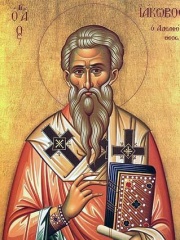
10. James, brother of Jesus (20 BC - 69)
With an HPI of 84.07, James, brother of Jesus is the 10th most famous Israeli Religious Figure. His biography has been translated into 52 different languages.
James the Just, or a variation of James, brother of the Lord (Latin: Iacobus from Hebrew: יעקב, Ya'aqov and Ancient Greek: Ἰάκωβος, Iákōbos, can also be Anglicized as "Jacob"), was, according to the New Testament, a brother of Jesus. James was personally known to Paul the Apostle (Gal 1:19). He was the first leader of the Church of Jerusalem. Traditionally, it is believed he was martyred either in 62 AD by being stoned to death on the order of High Priest Ananus ben Ananus, or in 69 AD by being thrown off the pinnacle of the Temple by scribes and Pharisees and then clubbed to death. James, Joses, Simon, and Judas are mentioned as the brothers of Jesus as well as two or more unnamed sisters.(See Matthew 13:55; Mark 6:3.) Catholics, Orthodox, and some Protestants teach that James, along with others named in the New Testament as brothers of Jesus, were not the biological children of Mary, mother of Jesus, but were cousins of Jesus, or step-brothers from a previous marriage of Joseph (as related in the non-canonical Gospel of James). Others consider James to be the son of Mary and Joseph. The Catholic tradition holds that this James is to be identified with James, son of Alphaeus, and James the Less. It is agreed by most that he should not be confused with James, son of Zebedee also known as James the Great.
People
Pantheon has 56 people classified as Israeli religious figures born between 1900 BC and 1937. Of these 56, 1 (1.79%) of them are still alive today. The most famous living Israeli religious figures include Michel Sabbah. The most famous deceased Israeli religious figures include Mary, mother of Jesus, Jesus, and Saint Joseph.
Living Israeli Religious Figures
Go to all RankingsDeceased Israeli Religious Figures
Go to all RankingsMary, mother of Jesus
100 BC - 100
HPI: 96.94
Jesus
4 BC - 33
HPI: 94.24
Saint Joseph
100 BC - 100
HPI: 90.76
John the Baptist
20 BC - 31
HPI: 89.07
Matthew the Apostle
10 - 74
HPI: 88.31
Isaac
1900 BC - 1533 BC
HPI: 86.63
Elijah
1000 BC - 900 BC
HPI: 85.72
Jonah
850 BC - 810 BC
HPI: 84.79
Matthias the Apostle
1 - Present
HPI: 84.11
James, brother of Jesus
20 BC - 69
HPI: 84.07
Samson
1118 BC - 1078 BC
HPI: 83.97
Mary Magdalene
10 BC - 100
HPI: 83.67

